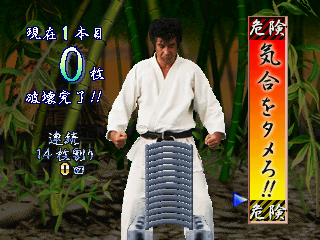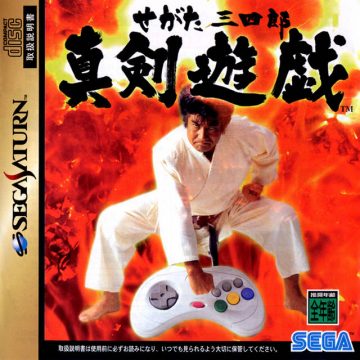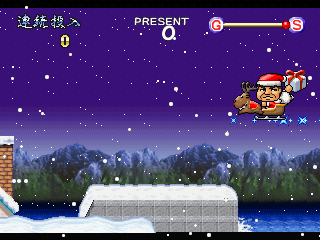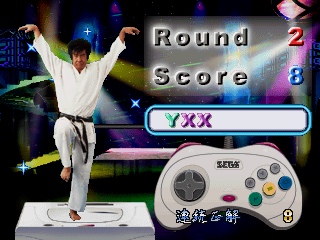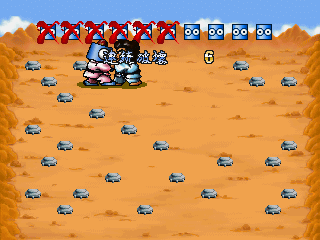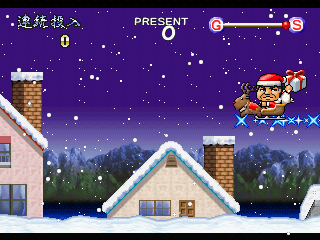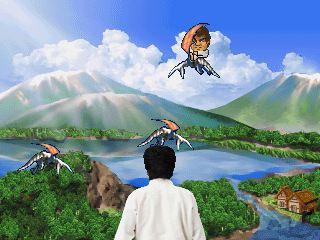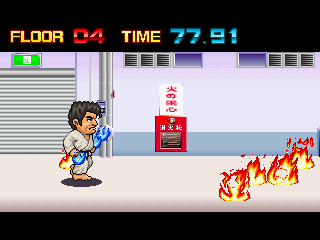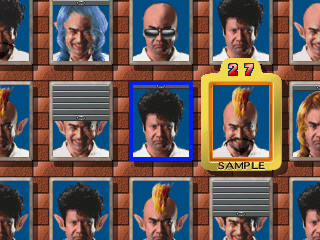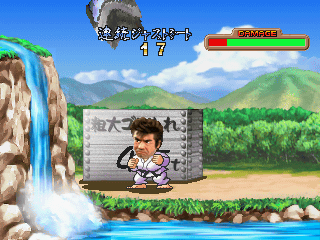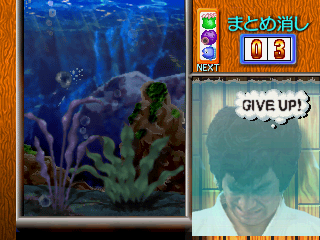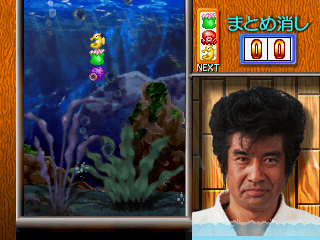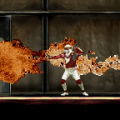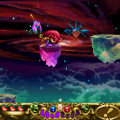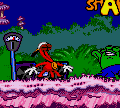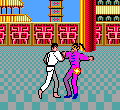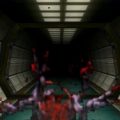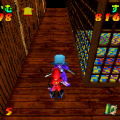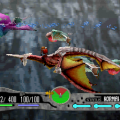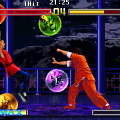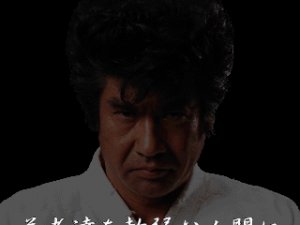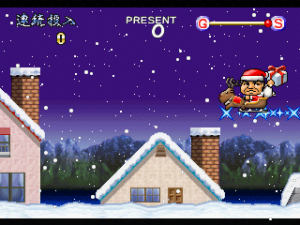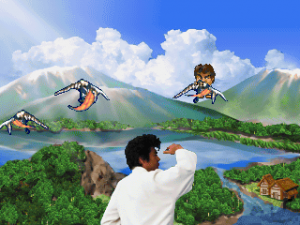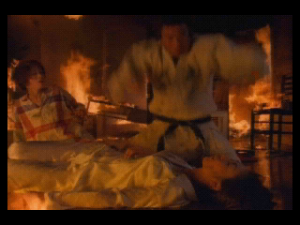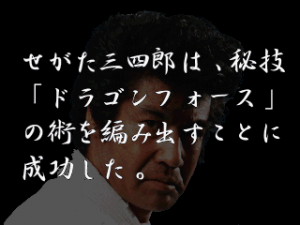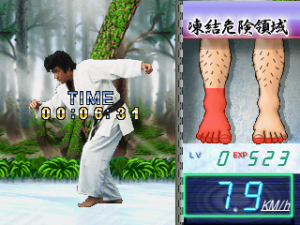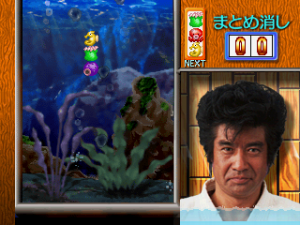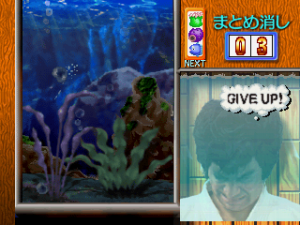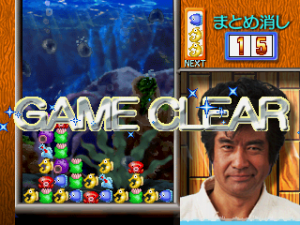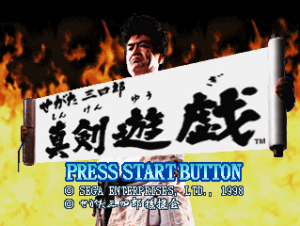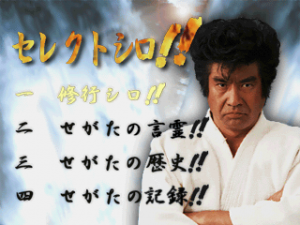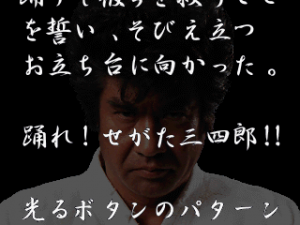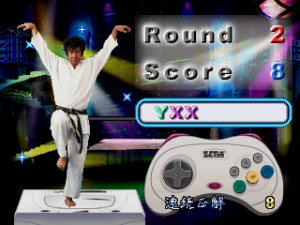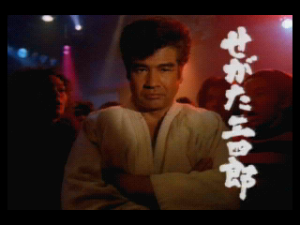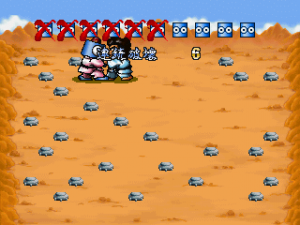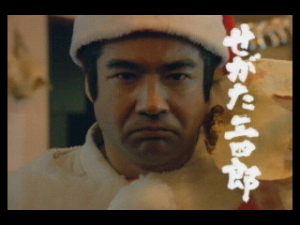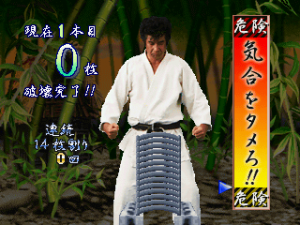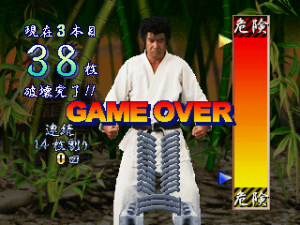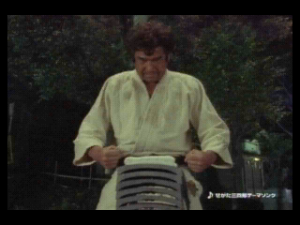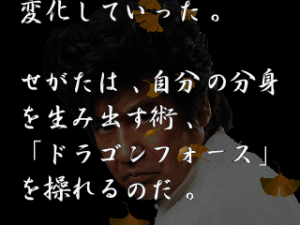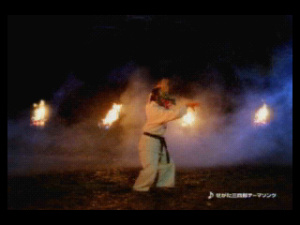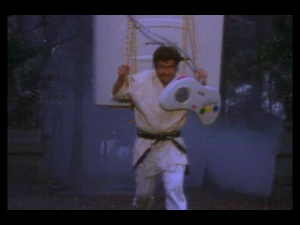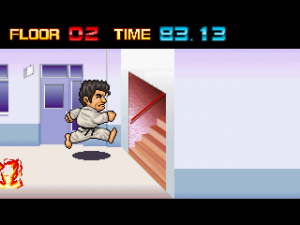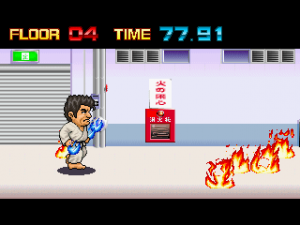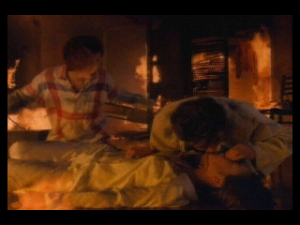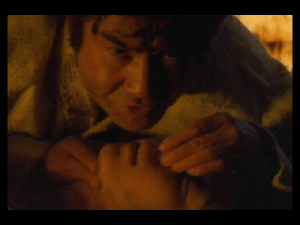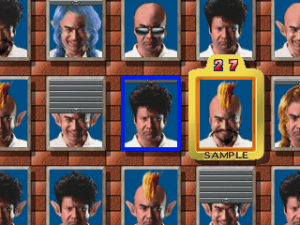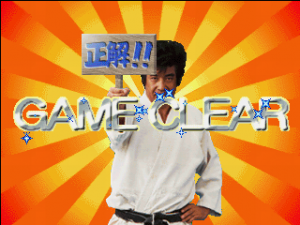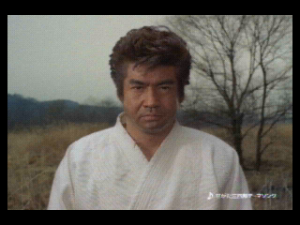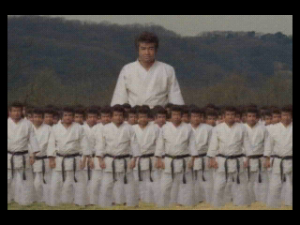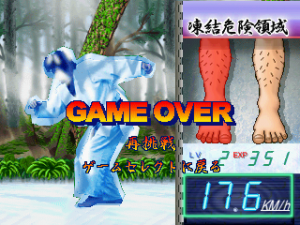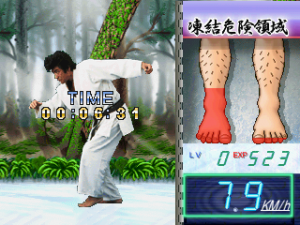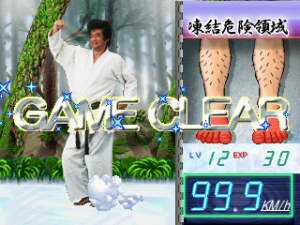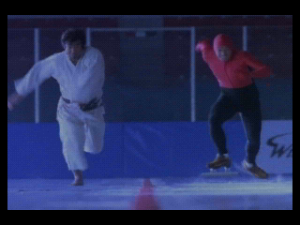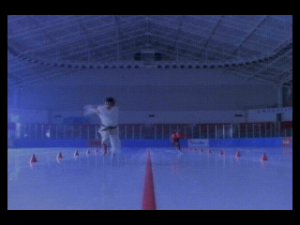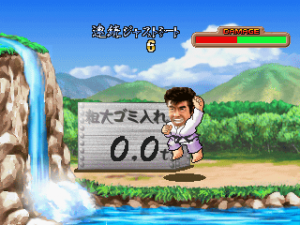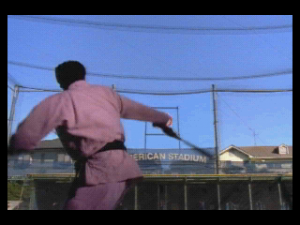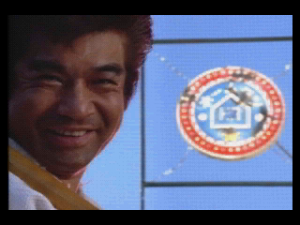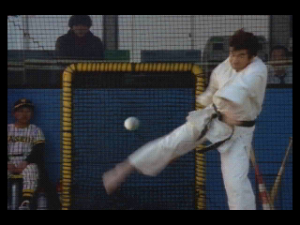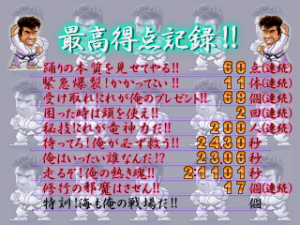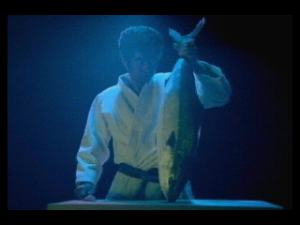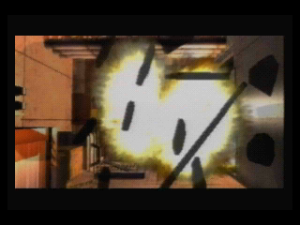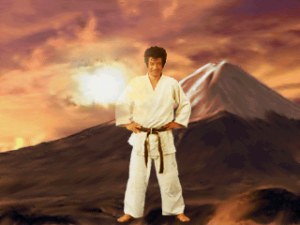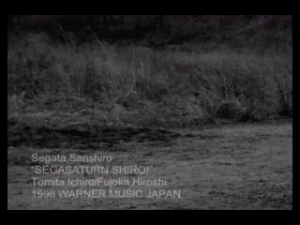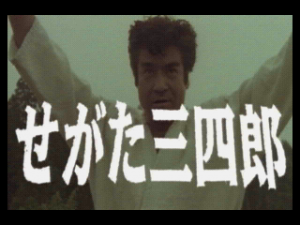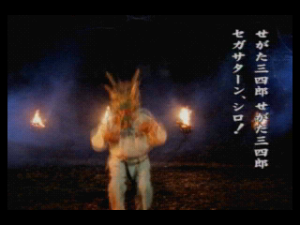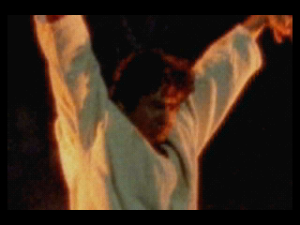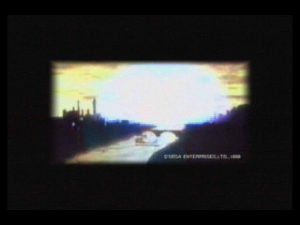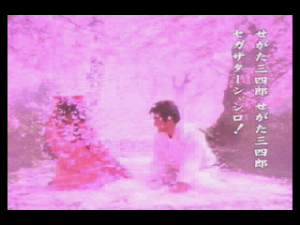While the Sega Saturn proved unpopular among contemporary American players, the system garnered far more love in Japan. Now a lot of this was because of a strong library of games (few of which were translated for international audiences) and a lack of the mismanagement that characterized the Saturn in the West. However, another reason for its success in Japan may have been because Segata Sanshiro kept the console’s momentum going even in its later years. First appearing on television in 1997, this early Kevin Butler predecessor, with his stern attitude and goofy pompadour, quickly earned the adoration of many gamers.
So it was only a matter of time before he started showing up in video games. Some of these appearances are minor cameos: he made his first (albeit brief) Western debut in Sonic & All-Stars Racing Transformed, and more recently shows up as a support unit in Project X Zone 2. But before all that, he made his video game debut in Segata Sanshiro Shinken Yuugi, a compilation of Sanshiro-themed mini-games released toward the end of the Saturn life cycle (less than a month before the Dreamcast’s release). As a marketing vehicle, Shinken Yūgi faithfully captures the Segata Sanshiro spirit. But as a game, its uninspired ideas of what constitutes amusement leave a lot to be desired.
Still, let it be said that after playing through the game, it’s easy to understand what makes Sanshiro such an appealing character. On one level, he’s repeating an obvious bit: the stoic figure who maintains an emotionless demeanor in the face of increasingly silly situations. Yet there’s more to the character than this routine would suggest. There’s an air of honesty behind the guy: he wants you to be just as aware as he is that he’s little more than a corporate mascot made to sell video game consoles. Not in a cynical way, mind you, but in an upfront and sincere way. Sanshiro’s often the one instigating these silly situations (like in the Panzer Dragoon RPG commercial), and he brings such a strong energy and enthusiasm to his performances that it’s hard not to be pulled in by it. Naturally, this applies to Shinken Yuugi, as well. The game presents itself with much the same over-the-top goofiness that Sanshiro was known for, such as opening to him slowly rising before a wall of flames or describing even his funniest moments with flowery language.
Unfortunately, the Segata Sanshiro spirit proves inadequate when it comes to making compelling gameplay. The goal of Shinken Yuugi is to complete a series of mini-games so you can unlock some of Sanshiro’s commercials. Those mini-games (and commercials) include:
I’ll show you the heart of the dance!!
(踊りの本質をみせてやる!!)
The video game equivalent of Simon. You’re given a sequence of button presses, and it’s your job to hit them in the right order to make Sanshiro dance. Scoring 60 points or more without failing unlocks the Shining Force III commercial.
Dangerous explosions! Bring ’em on!!
(緊急爆裂!かかってこい!!)
Sanshiro must grapple with a robotic opponent as they try to flip each other onto a nearby mine. Beating 10 opponents in a row unlocks the Bomberman Fight commercial.
Take this! It’s my present!!
(受け取れ!これが俺のプレセンと!!)
Segata Sanshiro is filling in for Santa as he delivers presents to the children. It’s his job to throw the presents directly into the chimneys (which often amounts to carpet-bombing the neighborhood with holiday cheer) and avoid all manner of obstacles. Delivering at least 70 presents unlocks the Segata Santa-shiro Christmas commercial.
When in doubt, use your head!!
(困った時は頭を使え!!)
A slight modification of Mortal Kombat‘s Test Your Might mini-game. Sanshiro has to break the boards with his head, but instead of filling up the bar, he achieves this by covering as much of the bar as possible with two well-timed button presses. (Think of the way you hit a ball in most golf games.) Breaking 40 boards unlocks the Solo Crisis commercial.
Secret technique! The Dragon God’s power!!
(秘技!これが竜神力だ!!)
Count the number of Sanshiros who fly by you. It’s a lot like the Roll Call mini-game from Mario Party 2. Completing 10 rounds in a row (IE without miscounting the number of Sanshiros) unlocks the Panzer Dragoon RPG commercial.
Hang on! I’m coming to rescue you!!
(待ってろ!俺が必ず救う!!)
Sanshiro has to dodge various obstacles (fire, collapsing floors, leaking gas pipes) to reach the top of a burning building and rescue the people trapped inside. Reaching the top floor in time unlocks the Burning Rangers commercial.
Just who the heck am I!?
(俺はいったい誰なんだ!?)
After messing up the timing on a body-doubling technique, Sanshiro ends up creating a group of dangerous clones. It’s his job to identify them in this Guess Who?-esque mini-game. Correctly identifying all six clones unlocks the Dragon Force 2 commercial.
Run! The heat of my soul!!
(走るぞ!俺の熱き魂!)
Sanshiro has to reach 100 km/hr by skating on the ice. In gameplay terms, this means switching which leg he’s standing on quickly enough that he doesn’t freeze to death, but not so quickly that he doesn’t gain EXP (and thus doesn’t accelerate). Hitting the 100 km/hr mark unlocks the Winter Heat commercial.
I won’t allow anything to interrupt my training!!
(修行の邪魔はさせん!!)
Raining piles of trash keep interrupting Sanshiro’s training. It’s his job to line himself up with where they’re going to land and kick the garbage into the nearby dumpster. Filling it with 16 tons of waste unlocks the Greatest Nine ’98 commercial.
Special training! Even the ocean is my battlefield!!
(特訓!海も俺の戦場だ!!)
A simple Columns-esque match-three puzzle game. Pulling off combos keeps Sanshiro from drowning, and eliminating 15 fish with a single move unlocks the Deep Fear commercial.
(Completing all ten mini-games unlocks a congratulatory message from Segata himself and a music video of his exploits. It’s worth mentioning that the video draws from commercials outside the ones you can unlock, like the Sakura Taisen II commercial.)
The problem with these games isn’t that they’re inconsistent with Sanshiro’s sense of humor. In fact, they excel along those lines. It’s that Shinken Yūgi can only conceive of them as vehicles for the Segata Sanshiro brand. This is why none of the games are ever more complex than early arcade games: because the game expects its sense of humor to carry the whole experience. Unfortunately, that was never going to work. Sanshiro’s antic may not have offered Sega enough to work on, but more importantly, the developer didn’t consider what role play can have in facilitating humor. It’s not something you can ignore. Play is one of the primary ways people engage with games, so no matter how strong a given joke may be, it loses some of its power if playing the game only distracts us from it. This is exactly the case with Shinken Yuugi: despite how consistent the humor is, the quality of the games themselves varies wildly. While kicking trash into a dumpster and keeping Sanshiro alive underwater are entertaining enough, matching photographs and counting how many Sanshiros fly by feels like work.
And to be perfectly honest, it’s hard to see why Sega decided to include these mini-games in the first place. The obvious answer is that they give the game structure; that if you could watch the commercials without having to play these mini-games, you’d never play them at all. But an explanation like that only draws attention to how dull they can be, since you wouldn’t need outside motivation if they were enjoyable on their own. In addition, this kind of framework makes the game look more cynical than it’s trying to be. What value do any of these activities have if the point of Shinken Yuugi is to become excited for any game other than the one you’re currently playing?
Perhaps the best value Shinken Yuugi has is historical value. A cliche sentiment, but not without merit: given how normal it was for Saturn owners to import the best games from Japan, it’s likely this game was the earliest exposure Western audiences had to Segata Sanshiro. And because the game collected most of his commercials in one convenient place, players could easily share the videos online and grow his cult following to what it is today. However, it’s important to remember that this perspective speaks around the game, not about it. Although Shinken Yuugi garnered a cult following after its release, that had more to do with its association with Segata Sanshiro than any virtues of its own. So while the game remains interesting as a historical curiosity, it doesn’t hold up nearly as well as a piece of entertainment.
Links:
All of Segata Sanshiro’s commercials
Complete playthrough of Shinken Yuugi
